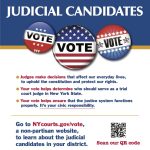Deadline June 30 at 8 pm ET
The Nominations and Elections Subcommittee is accepting nominations for Officer and Director candidates and applications for At-Large Board Member candidates for the 2023-24 NAPABA Board of Governors through June 30 at 8 pm ET. Officers and Directors are elected positions and At-Large Board Members are appointed to serve.
As the nation’s largest Asian American and Native Hawaiian Pacific Islander (AA and NHPI) membership organization, NAPABA continues to grow exponentially—maturity, stature, and staff. The NAPABA Board of Governors cultivates the strategic direction of the organization, provides resources to achieve goals and strategy, and exercises oversight ensuring the advancement of NAPABA’s strategic plan. The governing Board of 23 and national staff of eight complement and collaborate with each other—together united with a shared focus on advancing NAPABA’s mission through different perspectives and actions.
NAPABA is committed to having a governing board that reflects the diverse AA and NHPI legal community and has the right blend of skill, expertise, community connections, and diverse perspectives. We value an inclusive culture that embraces our diversity and empowers leaders to engage with each other and the community in a meaningful way by building trust, increasing transparency, and maximizing impact. We seek outstanding individuals of high character and integrity with proven leadership and board governance skills and who have demonstrated a strong commitment to NAPABA. The deadline for Officer and Director nominations and applications for At-Large Board Member candidates is June 30, 2023 at 8:00 pm ET.
To be considered for a NAPABA Officer, Director, or At-Large position, candidates must be a current individual member in good standing as of the date that the nominations or applications are submitted.







